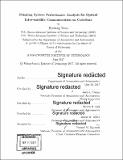Pointing system performance analysis for optical inter-satellite communication on CubeSats
Author(s)
Yoon, Hyosang
DownloadFull printable version (14.98Mb)
Other Contributors
Massachusetts Institute of Technology. Department of Aeronautics and Astronautics.
Advisor
Kerri L. Cahoy.
Terms of use
Metadata
Show full item recordAbstract
Free-space optical communication using lasers (lasercom) is a leading contender for future space-based communication systems with potential advantages over radio frequency (RF) communication systems in size, weight, and power consumption (SWaP). Key benefits are due to the shorter wavelength: additional bandwidth and narrow beam width. The narrower beam supports higher energy density for a given aperture size, so that lasercom can transmit data at the same rate with smaller SWaP as well as improve link security since the beam footprint is smaller. Lasercom is an attractive option for improving inter-satellite links (ISL) for resource-constrained CubeSats, which have emerged as a standard form of a small satellite since 1999. However, lasercom requires much more accurate pointing because of its narrower beam width. Accurate pointing is not trivial for most CubeSat platforms due to their resource constraints. A typical 3U CubeSat is 34 cm x 10 cm x 10 cm with less than 5 kg mass and about 10 W of available orbit-average power. This thesis presents pointing and tracking technologies to support lasercom on CubeSats. It covers three critical issues: (1) attitude determination and control of CubeSats, (2) relative orbit determination, and (3) development of a miniaturized fine beam pointing module. New attitude determination and control algorithms are developed, simulated, and validated with hardware in the loop demonstrations; results indicate that lasercom at data rates competitive with or better than RF is feasible on CubeSats. For attitude determination and control (ADC), this thesis develops a new attitude estimation algorithm, which is called Attitude and Parameter estimation Kalman filter (APKF). Attitude determination (AD) is thought to be more challenging than attitude control (AC) for CubeSats because of the limited capabilities of sensors that are compatible with the small form factor and resource constraints of CubeSats. The largest difference between a CubeSat and a larger satellite is the gyroscopes that measure rotation rates. Since a CubeSat is normally not able to accommodate high quality gyroscopes, the APKF is used to improve estimation without relying on gyroscope measurements. The APKF estimates CubeSat attitude and body rates as well as other unknown parameters such as the moment of inertia (MOI), actuator alignment, and the residual dipole moments. For relative orbit determination, this thesis describes an estimation algorithm that fuses different types of orbital measurements using the Kalman filter. There are three measurements that can be used in the relative orbit estimation for low earth orbiting (LEO) lasercom crosslink CubeSats: Global Navigation Satellite System (GNSS) navigation solutions for an individual satellite (e.g. Satellite A or "SatA"), beacon beam measurements at SatA, and GNSS navigation solutions of the other satellite (SatB) transferred through ground station networks. The GNSS and beacon are measured at SatA, so these can be assumed to have negligible time delay, but the arrival time of the SatB navigation solutions will be an out-of-sequence measurement (OOSM) whose arrival time will be delayed due to the ground station relay. To fuse the sensor data with different measurement times, a new algorithm called the Augment Fixed- Lag Smoother (AFLS) is developed. To update the Kalman filter with an OOSM, the AFLS generates the estimates at the measurement time of the OOSM by interpolation. The AFLS is applied to a nonlinear system as the extended AFLS (EAFLS). The Satellite Tracking Kalman Filter (STKF) is developed using the EAFLS. The fine pointing system (FPS) is necessary because while the CubeSat attitude determination and control and the orbit determination developments cover the Cube- Sat's body pointing capability, due to the extremely narrow beam desired for high-rate laser communications, body pointing alone cannot satisfy the beam pointing requirements. The example case used in this thesis is a CubeSat design concept mission with an inter-satellite laser communication link. To reduce the pointing error, a FPS needs to be implemented as the final stage for beam pointing. This thesis demonstrates the feedback control loop of the FPS using a hardware-in-the-loop test. A key component of the FPS is the miniaturized micro-electro-mechanical systems (MEMS) fast steering mirror (FSM) which is the actuator used to point the laser beam. Using a commercial-off-the-shelf (COTS) MEMS FSM that is also planned for use on the flight module, the fine pointing control loop has been demonstrated with results that show that it is feasible to meet the pointing requirement for a 3U CubeSat mission whose goal is 20 Mbps link at 25 km to 1000 km crosslink range. By developing and demonstrating the critical technologies for both spacecraft body pointing and the fine beam pointing, this thesis has demonstrated the feasibility of a CubeSat lasercom crosslink at a data rate and form factor that can outperform RF, leading to a high-speed and secure ISL for CubeSats.
Description
Thesis: Ph. D., Massachusetts Institute of Technology, Department of Aeronautics and Astronautics, 2017. Cataloged from PDF version of thesis. Includes bibliographical references (pages 175-181).
Date issued
2017Department
Massachusetts Institute of Technology. Department of Aeronautics and AstronauticsPublisher
Massachusetts Institute of Technology
Keywords
Aeronautics and Astronautics.